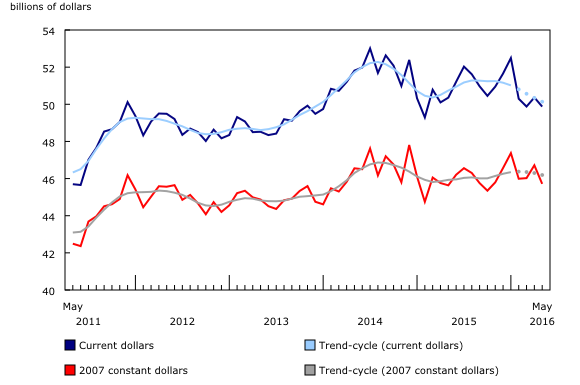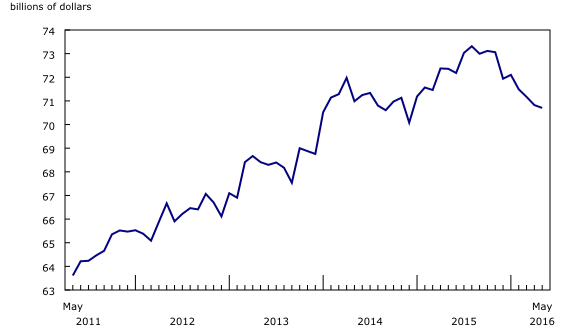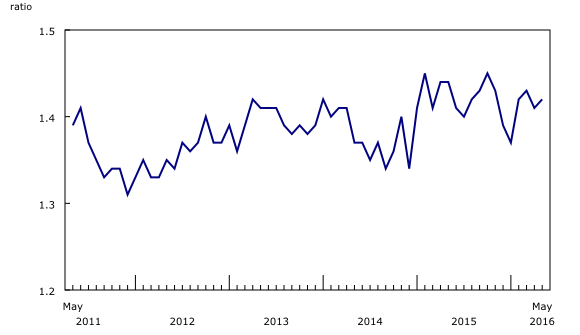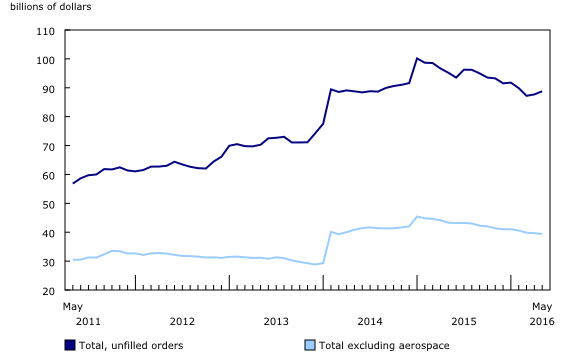Monthly Survey of Manufacturing, May 2016
Archived Content
Information identified as archived is provided for reference, research or recordkeeping purposes. It is not subject to the Government of Canada Web Standards and has not been altered or updated since it was archived. Please "contact us" to request a format other than those available.
Released: 2016-07-15
Manufacturing sales declined 1.0% to $49.9 billion in May, the third decrease in five months. The decline in May reflected lower sales of motor vehicles and petroleum and coal products.
Sales fell in 15 of 21 industries, representing nearly 70% of total Canadian manufacturing.
Constant dollar sales were down 2.1%, indicating that a lower volume of manufactured goods was sold in May.
Sales of motor vehicles and petroleum and coal products decline
Motor vehicle sales fell 4.2% to $5.6 billion in May, while sales of motor vehicle parts declined 2.3%. The declines in both industries were partly as a result of supply interruptions associated with the earthquake in Japan in April.
Sales in the petroleum and coal products industry were down 2.2% to $4.1 billion in May, following gains in March and April. The decline was entirely attributable to lower volumes of product sold, as prices for the industry rose 6.4%, according to the Industrial Product Price Index. The decrease in volumes partly reflected the effect of the Fort McMurray wildfire and evacuation. Maintenance and turnaround work at some facilities also lowered sales.
The fabricated metal product (-2.7%), computer and electronic product (-6.4%), and primary metal (-1.6%) industries were also down.
Partially offsetting these declines was a 4.6% advance in production in the aerospace product and parts industry. Gains were widespread in the aerospace industry and were partly due to the increase in the value of the US dollar relative to the Canadian dollar. Inventories are used to calculate production in the aerospace industry and most inventories in the industry are held in US dollars.
Sales of plastics and rubber products (+3.2%), food (+0.8%), and wood products (+2.6%) also rose in May.
Wood product manufacturing rose for the 7th time in 10 months in May, with sales 16.2% higher than in the same month the previous year, partially reflecting a 2.7% increase in prices.
Sales down in five provinces
Sales were down in five provinces in May, with Ontario registering the largest decline.
In Ontario, sales dropped 1.4% to $24.5 billion, reflecting lower sales in 13 of 21 industries. Three-quarters of the provincial decline was attributable to a 4.5% decrease in motor vehicle sales. Sales in the motor vehicle parts industry were down 2.4% to $2.3 billion. Lower sales in the chemical industry (-3.7%) and the computer and electronic product (-5.8%) industry also contributed to the provincial decrease.
Manufacturing sales in Alberta fell 2.0% in May to $5.0 billion, following two consecutive monthly gains. A 12.2% drop in the petroleum and coal product industry, partly reflecting the effect of the Fort McMurray wildfire and evacuation, was the main contributor to the provincial decline. Lower non-metallic mineral product sales (-16.1%) also contributed to the decline. A 5.4% rise in the chemical industry and a 6.2% gain in the wood product industry partly offset these decreases.
In British Columbia and Nova Scotia, sales were up in both the durable and non-durable goods industries, offsetting a small portion of the overall national decline.
Inventories decrease
Inventories fell for the fourth consecutive month, down 0.2% to $70.7 billion in May, the lowest level since December 2014. Inventories were down in 12 of 21 industries. Petroleum and coal recorded the largest decrease, with inventory levels down 3.8%. Lower inventories in the primary metal (-0.3%) and motor vehicle (-0.8%) industries also contributed to the overall decrease. These declines were partly offset by higher inventories of food products (+0.5%).
The inventory-to-sales ratio rose from 1.41 in April to 1.42 in May. This ratio measures the time in months that would be required to exhaust inventories if sales were to remain at their current level.
Unfilled orders increase
Unfilled orders rose for the second consecutive month, up 1.3% to $88.8 billion in May as a result of a gain in the aerospace product and parts industry.
Unfilled orders in the aerospace industry rose 2.8% to $49.4 billion. The gain was attributable to the increase in the value of the US dollar relative to the Canadian dollar during the month. The majority of unfilled orders in the industry are held in US dollars.
New orders rose 0.3%, as a result of growth in the aerospace product and parts industry.
Fort McMurray wildfire and evacuation
When collecting data for the May reference month, the Monthly Survey of Manufacturing added three supplementary questions to a national sample of about 3,600 respondents to assess the effect of the Fort McMurray wildfire that started in early May.
Overall, 5.4% of the sample or 194 manufacturers, reported that their business activities in May were affected by the wildfire and evacuation in the Fort McMurray area. Out of these 194 respondents, approximately 40% reported a loss of sales in terms of percentages and/or dollar values. The remaining 60% indicated that they were affected, but were not able to quantify the effects of the fire. Several manufacturers in the wood product industry noted an increase in their sales, in anticipation of rebuilding. This gain was very small compared with sales in the industry as a whole.
The responses to the supplementary questions indicated that the wildfire and evacuation were partly responsible for lower sales in the petroleum and coal product industry in May. National sales in the industry were down 2.2%, despite a 6.4% gain in prices, as measured by the Industrial Product Price Index.
For the rest of the manufacturing sector, some manufacturers, primarily in Alberta and Ontario, reported lower sales as a result of the wildfire and evacuation. In Alberta, 70 respondents to the supplemental questions indicated that they were affected, reflecting the fact that many manufacturing firms in the province supply machinery and equipment to the oil and gas extraction sector.
Meanwhile, 48 manufacturers in Ontario indicated that they were affected as well. Ontario manufactures numerous products for the oil and gas extraction sector in Alberta. Effects were also reported in British Columbia (27 respondents), Saskatchewan (17 respondents) and Manitoba (12 respondents).
Respondents in Quebec and the Atlantic provinces reported relatively fewer effects. It is difficult to determine the overall effect of the wildfire and evacuation on manufacturing sales and inventories in dollar terms given that 60% of respondents who specified that their firm was affected did not quantify the impact.
Note to readers
Monthly data in this release are seasonally adjusted and are expressed in current dollars unless otherwise specified. For more information on seasonal adjustment, please refer to Seasonally adjusted data – Frequently asked questions.
For more information on the trend-cycle data, see Trend-cycle estimates – Frequently asked questions.
Non-durable goods industries include food, beverage and tobacco products, textile mills, textile product mills, clothing, leather and allied products, paper, printing and related support activities, petroleum and coal products, chemicals, and plastics and rubber products.
Durable goods industries include wood products, non-metallic mineral products, primary metal, fabricated metal products, machinery, computer and electronic products, electrical equipment, appliances and components, transportation equipment, furniture and related products, and miscellaneous manufacturing.
Production-based industries
For the aerospace industry and shipbuilding industries, the value of production is used instead of sales of goods manufactured. This value is calculated by adjusting monthly sales of goods manufactured by the monthly change in inventories of goods in process and finished products manufactured. Production is used due to the extended period of time that it normally takes to manufacture products in those industries.
Unfilled orders are a stock of orders that will contribute to future sales assuming that the orders are not cancelled.
New orders are those received whether sold in the current month or not. New orders are measured as the sum of sales for the current month plus the change in unfilled orders from the previous month to the current month.
Manufacturers reporting in US dollars
Some Canadian manufacturers report sales, inventories and unfilled orders in US dollars. These data are then converted to Canadian dollars as part of the data production cycle.
For sales, based on the assumption that they occur throughout the month, the average monthly exchange rate for the reference month (noon spot rate) established by the Bank of Canada is used for the conversion. The monthly average exchange rate is available on CANSIM table 176-0064.
Inventories and unfilled orders are reported at the end of the reference period. For most respondents, the noon spot exchange rate on the last working day of the month is used for the conversion of these variables. However, some manufacturers choose to report their data as of a day other than the last day of the month. In these instances, the noon spot exchange rate on the day selected by the respondent is used. Note that because of exchange rate fluctuations, the noon spot exchange rate on the day selected by the respondent can differ from both the exchange rate on last working day of the month and the monthly average exchange rate. Noon spot exchange rate data are available on CANSIM table 176-0067.
Revision Policy
Each month, the Monthly Survey of Manufacturing releases preliminary estimates for the reference month and revised estimates for the three previous months. Revisions are made to reflect new information provided by respondents and updates to administrative data. Once per year, a revision project is undertaken where multiple years of data are revised. During annual revisions, changes are made to our seasonal adjustment parameters.
Real-time CANSIM tables
Real-time CANSIM tables 304-8014, 304-8015 and 377-8009 will be updated on July 26. For more information, consult the document, Real-time CANSIM tables.
Next Release
Data from the June Monthly Survey of Manufacturing will be released on August 16.
Products
To enquire about the concepts, methods or data quality of this release, contact Michael Schimpf (613-863-4480; michael.schimpf@canada.ca), Manufacturing and Wholesale Trade Division.
Contact information
For more information, contact us (toll-free 1-800-263-1136; 514-283-8300; STATCAN.infostats-infostats.STATCAN@canada.ca).
- Date modified:







